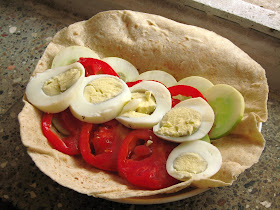Photo (c) Sam Foster
The topic of food porn sparked off in the middle of another farewell. (This farewell was memorable with Dipali giving us all some awesome chocolate cake)
Manasi quickly logged on to tumblr and showed us some very mouthwatering photos. She commented that all this 'food porn' is responsible for most of the obesity in this world. This got me curious. What is 'food porn'?
Now, wikipedia sounds very pedantic (http://en.wikipedia.org/wiki/Food_porn) and holds feminist critic Rosalind Coward responsible and quotes her thus...
"her 1984 book Female Desire[4] in which she writes: "Cooking food and presenting it beautifully is an act of servitude. It is a way of expressing affection through a gift... That we should aspire to produce perfectly finished and presented food is a symbol of a willing and enjoyable participation in servicing others. Food pornography exactly sustains these meanings relating to the preparation of food. The kinds of picture used always repress the process of production of a meal. They are always beautifully lit, often touched up." (p.103)"
And yes! Nigella Lawson is held responsible for making (food) lascivious and prurient as the Queen of Food Porn.
:P I whole heartedly agree!
Skinny gourmet does a much better job with an interesting write-up about the origins of the term.
"Frederick Kaufman's article entitled: "Debbie Does Salad: The Food Network at the frontiers of pornography," originally published in Harper's Magazine in October 2005."
Kaufman's original article was a delightful read (http://www.harpers.org/archive/2005/10/0080776)
"Kaufman’s article talks mostly about how camera techniques and ways of looking, the "pornographic gaze," have been incorporated into the visual presentation of food. He talks through how specific techniques of filming from the pornography industry--such as "swooping" over food--and traditions of presentation--such as repetition--have been adopted wholesale by Food TV. Although sometimes it seems to be an over-extended phrase, not everything is food porn. For a classic example of food porn in video, think of Giarda cooking. The close ups as the flame bursts from the burner, a zoom in on her eagerly licking melted chocolate from her finger-tip. When the final food is presented the camera swoops in like Fabio to a fainting maiden. The camera trails lovingly across the food, tracing the curves and confines, lingering. This is a far cry from the quirky (but endearing) camera-work that characterizes Alton Brown’s show."
I mentally compared this and the Discovery TLC programs to the ones we get to see in India television... Yuck!
You get dumpy aunty blinking and stirring with a chirpy and vacuous idiot bouncing beside her. The camera is glued with a fixed gaze to everyone with occasional zoom-ins to glass/ceramic bowls of chopped ingredients.
The boob tube in the land of kama sutra has collective (and severe) erectile dysfuntion. With food channels rearing their heads, I am really hoping for the 'masala' to kick in...
In the meanwhile, I leched at the food shot in Veggie Num Num's Flickr stream. Tons of enticing looking things at Flickrmindhive. I stumbled upon the fact that Flickr actually has a Food Porn Group!
Some more interesting things to watch and read lie here:
- Drool over the hotties in - http://fiveprime.org/flickr_hvmnd.cgi?method=GET&page=3&photo_number=50&tag_mode=all&search_type=Tags&sorting=Interestingness&photo_type=250&noform=t&search_domain=Tags&sort=Interestingness&textinput=foodporn
- Even if you skip the rest of the article, read the part about 'Producing the Pornographic Aesthetic' at http://skinnygourmet.blogspot.com/2008/02/what-is-food-porn.html
This part describes the process and methods of creating hot looking photos from food - http://www.tastespotting.com/ aggregates interesting food droolables from all over the internet.
- Eating taipei (http://www.flickr.com/photos/yusheng/sets/679140/with/370465445/) has very nice food shots from.... Well... Taipei.
- Don't miss New York Times' short tutorials on photographing gorgeous looking food (http://dinersjournal.blogs.nytimes.com/2010/04/06/how-to-take-photos-of-food/)
- Read about people with a fetish for photographing whatever they eat at (http://www.nytimes.com/2010/04/07/dining/07camera.html?_r=1)
- And well... Another Flickr group... Called "I ate this..." (http://www.flickr.com/groups/i_ate_this/)
I'd love to know what you've found as well... :)































